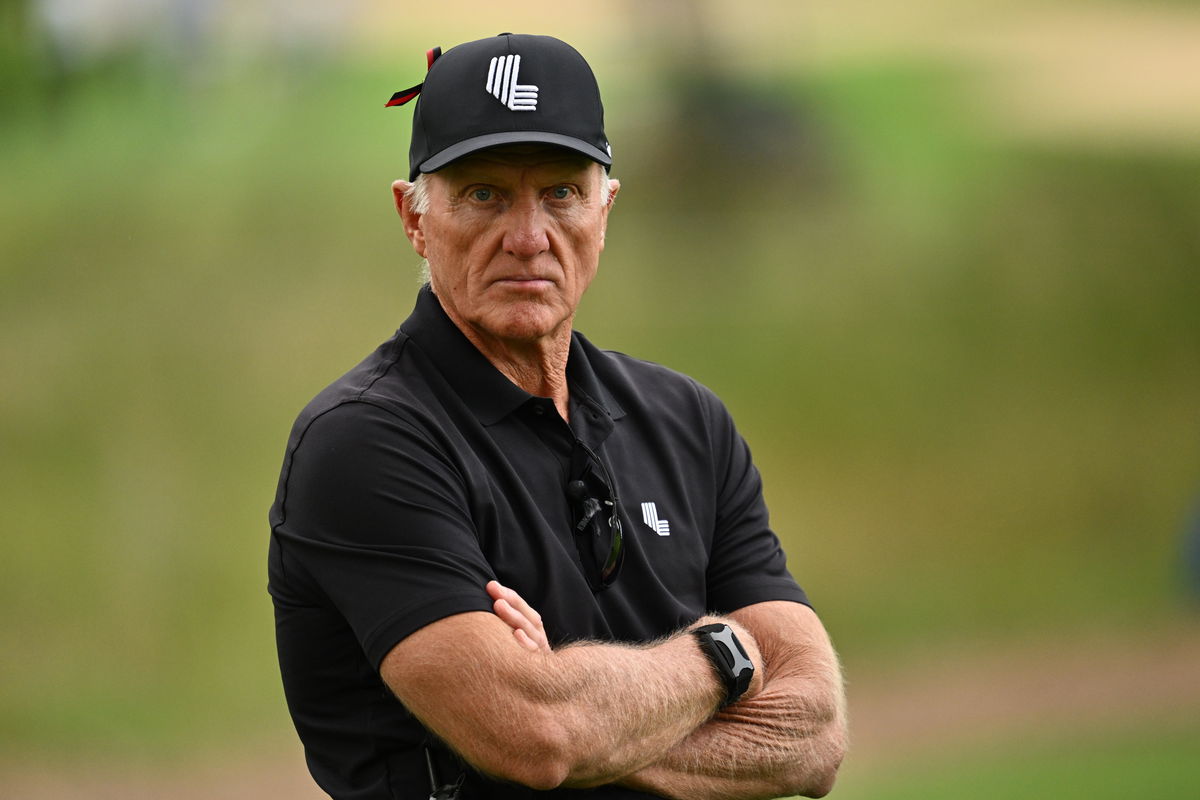
USA Today via Reuters
Sep 24, 2023; Sugar Grove, Illinois, USA; Greg Norman watches the action on the 11th green during the final round of the LIV Golf Chicago golf tournament at Rich Harvest Farms. Mandatory Credit: Jamie Sabau-USA TODAY Sports

USA Today via Reuters
Sep 24, 2023; Sugar Grove, Illinois, USA; Greg Norman watches the action on the 11th green during the final round of the LIV Golf Chicago golf tournament at Rich Harvest Farms. Mandatory Credit: Jamie Sabau-USA TODAY Sports
Greg Norman sold LIV Golf as a player-first revolution, but shifting rules and backstage silence told a different story. Now, as contracts approach expiration, the cracks are harder to ignore. What began as a disruption has turned into disillusionment for some. One former LIV pro says it all started with a lack of transparency, especially when things got personal. When he got injured, the support system collapsed.
Watch What’s Trending Now!
The player? Hudson Swafford, a three-time PGA Tour winner and early believer in LIV’s promise. This week, from shifting policies to poor injury handling, the 37-year-old didn’t hold back. “Things I didn’t like—you know, the lack of transparency, the rule changing… You never knew where we stood week to week.” He recalled pressing for answers on multiple fronts but hitting walls. “It was very tough. I basically created their injury policy, and I still don’t think it’s very black and white over there,” he stated on GOLF’s Subpar podcast with Colt Knost and Drew Stoltz.
When he got hurt, LIV hadn’t established any formal support for sidelined players. He had to push for clarity while rehabbing, unsure if his contract would be honored. By failing to plan ahead, LIV exposed a deeper flaw—it reacted instead of leading. LIV built itself as player-friendly, yet failed to prepare for basic professional realities like injuries. Swafford’s experience shows how the system lacked foresight. For a league courting top talent, that’s a dangerous oversight.
ADVERTISEMENT

USA Today via Reuters
Jan 23, 2022; La Quinta, California, USA; Hudson Swafford reacts after a putt on the 18th green during the final round of the American Express golf tournament at Pete Dye Stadium Course. Mandatory Credit: Orlando Ramirez-USA TODAY Sports
Still, LIV eventually honored his deal and allowed him to play again. But the delay and doubt had already done damage. “Until it was almost too late.” That moment changed how he viewed LIV and what he’d risk again. Norman, the league’s CEO and public face, has insisted LIV offers “freedom, innovation, and respect for the player.” But stories like Swafford’s challenge that narrative. Norman’s hardline stance has already sparked internal friction. Back in 2023, The Telegraph reported that several high-profile LIV figures questioned his leadership, citing a lack of strategic clarity and poor communication. Some even reportedly pushed for his removal during board meetings.
Now, with LIV’s future on the line, its promises face renewed scrutiny. If rising stars and proven names begin walking away, LIV may not just lose players—it may lose the trust it was built on. For players like Swafford, the league’s biggest pitch—long-term stability—was already hard to believe. By 2026, others may feel the same.
ADVERTISEMENT
Top Stories
Pebble Beach Looks Unrecognizable as Harsh Weather Destroys Iconic Golf Course

PGA Tour Hands Veteran Pro 1-Year Ban Despite Severed LIV Golf Ties

Phil Mickelson’s LIV Golf Hope Shatters After Akshay Bhatia Decision

John Daly to Keep Masters Tradition Alive Despite Hooters’ Bankruptcy Shutdown

Tiger Woods Finally Answers Nelly Korda & Co.’s Demands With Major LPGA Announcement

No bonuses, no leverage. LIV stars weigh exits as Greg Norman’s empire faces a quiet collapse.
Greg Norman once promised players long-term loyalty and unprecedented financial backing. But with several top contracts—like Brooks Koepka’s—reportedly set to expire around 2026, some stars may be re-evaluating their future with LIV Golf. While Koepka and Bryson DeChambeau haven’t confirmed any plans to leave, they also haven’t ruled out the possibility of competing on the PGA Tour again.
ADVERTISEMENT
Reports suggest that Koepka and Dustin Johnson should not expect the same payouts again. That financial shift and Norman’s leadership style have players rethinking their long-term future with the league. Criticism is growing from inside the LIV circle. Former players have begun speaking out about unclear rules and broken communication. Now, as LIV approaches a critical contract cliff, even its most loyal faces could walk away. Now, with those payouts gone, retaining talent looks harder than recruiting ever was. Even players under contract like Jon Rahm may rethink their futures as competitive incentives shrink.
Meanwhile, the PGA Tour isn’t chasing reunification. Instead, it’s gaining leverage by simply waiting out the clock. As viewership rebounds and new backers wait in the wings, the Tour has little reason to compromise. Strategic Sports Group hasn’t even deployed its resources yet—Saudi influence no longer feels essential. And if even one LIV headliner returns, it could flip the sport’s power balance overnight.
LIV’s disruption once looked permanent. Now, it feels like a countdown. Without massive payouts, loyalty wavers—and silence grows louder. Norman still calls the shots, but for how long? With stars weighing exits and the PGA Tour playing the long game, LIV faces a test it can’t outspend. What happens next may not be decided in boardrooms—but in the choices players make when contracts expire.
ADVERTISEMENT
ADVERTISEMENT
ADVERTISEMENT
ADVERTISEMENT

